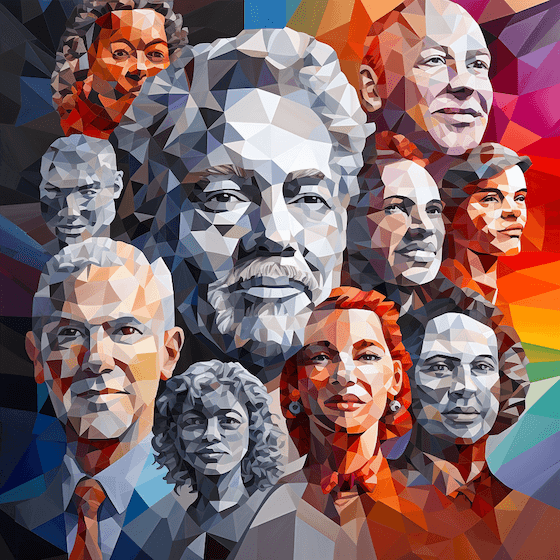Bias Impacts Your Business Decisions But You Can Learn To Control It If You Follow This Proven Advice

The human brain is hardwired to make generalizations.
Generalizations allow us to process the colossal amounts of input our brains encounter daily. They’re necessary for us to function and not be overwhelmed by data.
Generalizations also help by creating shortcuts in our brains.
Unfortunately, those shortcuts are a double-edged sword.
They allow us to move through the world and quickly assess a situation. But they also lead to unconscious biases that impact our interactions with others.
Whether talking to the guy in the drive-thru window, calling our sainted mothers, or chatting with our co-workers, unconscious bias influences how we perceive everyone.
Unconscious bias happens outside of our control. It happens automatically when our brain makes a quick judgment. The HR team at Advanced Systems, a workforce management provider, explains that biases are:
…automatic and unconscious ways our brains try to help us. We cannot notice, remember, and value everything. These are not bad things only bad people do. But bias is a problem.
Good managers can’t afford to allow their biases to impact how they perceive their teams. This is especially true when making hiring decisions, during annual performance reviews, or recommending promotions.
With so much at stake, you owe it to the other people you work with to see clearly and make appraisals based on reality.
The ability to ground your decisions in facts, not speculation, is one of the most powerful traits of great leaders.
So, let’s look at the most common types of leadership and management bias and ways to overcome bias in the workplace.
Similarity Bias
This bias is rooted in the classic “US vs. THEM” dichotomy.
Similarity bias states that we like people who are similar to us. Birds of a feather flock together, right?
And we tend to treat people we like well.
The danger here is that managers influenced by similarity bias may mistreat people who are different. These perceived differences could be based on age, race, sexual orientation, gender, or personality.
As I’m sure you know, biases against people of different races, genders, sexual orientations, or ages are considered discriminatory. And whether you truly harbor negative feelings for these groups or just subconsciously prefer people similar to you, the results are the same.

What You Can Do
Make an effort to find similarities with all of your co-workers. While you will always be naturally drawn to people who are clearly most similar to you, universal human traits connect us all. Getting to know your employees and finding common ground will humanize them and help level the playing field.
In-Group Bias
Most people have friends at work. These friends are our in-group.
Managers have in-groups, too. And in-group bias occurs when managers treat members of their in-groups better than out-group members.
We tend to think highly of the people we befriend. After all – they’re our friends.
But, if we’re not careful, we may make decisions that benefit our friends based on an over-inflated assessment of their abilities or simply out of the desire to help them get ahead.
In-group bias doesn’t stop with helping your friends. It can also actively manifest through behaviors that hinder your out-group. The Advanced Systems HR team points out:
The out-group is managed with more command and control, which reinforces the label by limiting their ability and motivation to grow and perform. No matter how well-intentioned the extra support and supervision, lack of confidence and appreciation lowers employee engagement, performance, and retention.
What You Can Do
Consciously identify the members of your in-group and out-group to raise your awareness of this issue. Then, take steps to avoid acting on positive or negative bias:
- Seek out the opinions of other managers and employees to help round out your perspective of your report’s work performance.
- Perform a self-assessment – can you be neutral regarding this employee? If the answer is no, remove yourself from the decision-making process.
- Do your best to remove your feelings from the equation. Gather facts (not perceptions) to support your appraisal of the employee.
Timing Biases
Some biases are based on timing. Here are three timing-related biases that may impact your relationships with co-workers.
First Impressions Bias
First impressions are powerful. They’re tied to a known psychological effect called anchoring in which people:
…unconsciously latch onto the first fact they hear, basing their decision-making on that fact… whether it’s accurate or not.
This is true when you’re negotiating a salary, buying a new car, seeing a business name or business logo for the first time, or appraising your coworkers.
First impression bias means that your first impression overrides the reality of the employee’s behavior since you’ve met them.
A first impression cannot possibly encompass an employee’s work performance or capabilities. Humans are not static; rather, they are constantly growing and evolving – for good or bad.
First-impression bias doesn’t leave room to acknowledge change or factor in new data. And that’s no good.
Spill-Over Bias
Spill-over bias occurs when a manager’s opinion of an employee is too heavily influenced by events that happened in the past.
If an employee had a stellar first year and then lets their performance slide, and you’re still fixated on their earlier performance – that’s spill-over bias.
Likewise, maybe an employee was a class clown during their training but pulled it together and delivered awesome results once their training was complete. If you can’t get past the idea of that employee as a sass-talking joker, then spill-over bias is at play.
Recency Bias
When a co-worker’s most recent actions unduly influence managers, they suffer from recency bias.
Let’s say an employee is troubled at home, and their work has suffered for a few weeks. A manager influenced by recency bias might overlook that employee’s positive contributions and strong performance earlier in the year.
An employee should be judged on the entirety of their work performance. It’s not fair or accurate to judge an employee’s overall performance only on first impressions or a portion of their working timeline.
What You Can Do
Make sure to touch base consistently with your employees and record your impressions. This running performance record will provide a more accurate view when the annual assessment time draws near. It’s also a good idea to perform reviews more frequently than once a year. Building closer relationships and assessing employees more frequently will help to sidestep timing biases and lead to stronger employee performance.
Expedience Bias
Ask ten people the same question, and you’ll likely get ten different answers. This is because people are formed by their life experiences, and we all walk a unique path.
Expedience bias occurs when managers think that just because it’s the most obvious answer to them, it must be true.
This bias is particularly compelling when a manager doesn’t want (or have the time) to dig deeper.
Relying on what seems to be obvious is quick and easy. However, as Beth Jones, Khalil Smith, and David Rock of Harvard Business Review point out:
Expedience bias tilts us toward answers that seem obvious, often at the expense of answers that might be more relevant or useful.
Imagine if a support representative were judged by how many daily calls she took. If you heard that on average, she only spoke with 12 clients per day, you might assume she was lazy or inept. That’s the “expedient” answer.
But what if you learned that each client was a high-value spender and had been planning to take their business elsewhere? And that 80% of her clients stayed with your business due to her efforts?
It’s important to look beyond what seems obvious to make sure that you understand the whole picture.
What You Can Do
Take the time to dig deeper. Make sure you understand the full context before drawing any conclusions. To help achieve this goal, work to understand the parameters that should be measured to truly understand each employee’s contributions. Then make sure those are the parameters that you measure.
The Harvard Business Review team also recommends setting pre-determined goals with your reports on which their performance can be assessed.
Confirmation Bias
Have you ever said, “I bet today is going to be an awful day,” and then turned out to be right?
There’s a good chance that this was confirmation bias at work.
Confirmation bias occurs when people focus primarily on the data that confirms their initial hypothesis.
This bias can be a secondary bias that piggybacks along with other biases.
For instance, Joel’s car broke down, and he arrived late on his first work day. Joel’s manager Kim remembers this and carries a negative first impression bias against Joel that never disappears. She mentally tracks every time Joel arrives late. These occasional infractions confirm her opinion of Joel as a late person.
Confirmation bias is seductively powerful. We all want to be right. This bias simply involves looking for the evidence you’re right while ignoring the evidence to the contrary.
What You Can Do
Learn to be your own “devil’s advocate.” Ask yourself if your argument is as air-tight as you think it is. Review the opposing evidence with an open mind. And seek alternative perspectives from others who know the employee or the topic. Most importantly, be willing to learn that you were wrong (if that is the case).
The Bias Game Changer: Emotional Intelligence
Emotional intelligence is key to overcoming all types of management bias.
If you don’t want to be a biased manager, focus on improving your emotional intelligence.
As we mentioned in a prior article,
Emotional intelligence (sometimes also called EI or EQ) is the ability to identify and regulate your own feelings, and the feelings of people around you.
And the cornerstone of emotional intelligence is self-awareness. That’s the ability to identify your feelings and appraise your motivations and behavior accurately.
This higher-level awareness of your emotions, motivations, and perceptions is essential to rising above the influence of your unconscious biases. As we previously explained:
You can modify your behavior for the better if you can identify your own bad habits and catch yourself when you’re doing them. So, in addition to creating the foundation for EQ, self-awareness is also the foundation for self-improvement.
The ultimate remedy to all types of bias is self-awareness. Bill George, the author of Finding Your True North, offers three great techniques for improving your self-awareness. Check them out here.
Design Done Better
The easiest way to get affordable, high-quality custom logos, print design, web design and naming for your business.
Learn How to Grow Your Business With Beautiful Design
